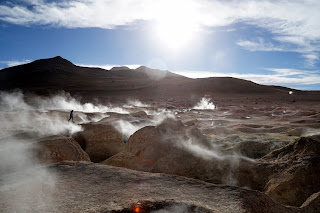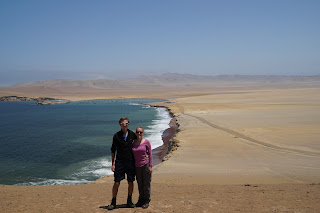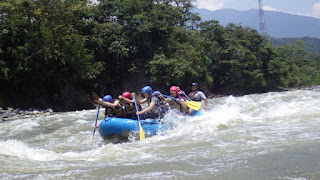The border post to leave Bolivia is basically a shed in the middle of the desert. After queueing for our stamp we caught a bus down from the altiplano to the Atacama desert and the town of San Pedro de Atacama. At this point we were in no-man's land as we didn't cross the official entry point to Chile until the town. San Pedro is small outpost in the middle of the driest desert on the planet and has swollen in size in recent years due to increasing numbers of tourists. Despite this it retains a pleasant and inviting feel. After 4 busy weeks travelling huge distances and doing many activities we decided to slow down for a couple of weeks in Chile. We spent a couple of days relaxing in San Pedro with a short afternoon trip to Valle de la Luna and a spectacular evening stargazing. Due to the high altitude and lack of humidity in the Atacama desert the conditions for viewing the night sky are arguably the best on the planet. Indeed NASA and several other space organisations have observatories in the area. We spent an hour having a talk about the night sky and what we could see with the naked eye before looking through 10 different high powered telescopes trained on different objects. We saw Mars, the Orion nebula, the Andromeda galaxy and a 'supercluster' of 300 million stars amongst other things.
Leaving the desert behind we finally returned to sea level for the first time in a month. We spent 4 relaxing days in La Serena on the Chilean coast making friends with an English girl called Katy and a German couple called Samira and Seb. Together the 5 of us surfed, ate and had a lot of fun doing not very much at all. We also discovered a shop selling very tasty custard doughnuts! Sometimes the joy of travelling is not seeing amazing sights, but making new friends and talking about our different views about, and experiences of, the world.
Valle de la Luna
Leaving the desert behind we finally returned to sea level for the first time in a month. We spent 4 relaxing days in La Serena on the Chilean coast making friends with an English girl called Katy and a German couple called Samira and Seb. Together the 5 of us surfed, ate and had a lot of fun doing not very much at all. We also discovered a shop selling very tasty custard doughnuts! Sometimes the joy of travelling is not seeing amazing sights, but making new friends and talking about our different views about, and experiences of, the world.
Fiona ready to surf
After a short stop in the town of Vicuña where we visited a Pisco distillery we headed south again to arrive at the port city of Valparaiso. The city became very wealthy and expanded rapidly in the 19th century as it was a major stop off point for ships from Europe on their way to California. Evidence of various European styles are evident in the older parts of the city and the grand buildings around the main plaza. Once the Panama Canal opened in the early 20th century growth stagnated and the city has never regained its former glory. We spent an interesting morning on another walking tour; in particular learning about the Pinochet dictatorship of the 1970's and 80's. It is still a controversial topic in Chile as many are still fans of the regime due to the economic prosperity and stability that it provided despite the evidence of terrible human rights abuses that took place (more on this later).
Street art by Un Color Distinto
Our friend Katy from La Serena caught up with us again in Valparaiso and we spent a fun day together wandering around the hill above the port. Here the buildings are laid out in a rather chaotic fashion with tiny alleyways and many staircases linking streets. There are a number of old funicular railways providing easy access back down to the port. The area has many great cafes, bars, restaurants and artisans stalls, but the highlight for us was the street art. Almost every available vertical surface is covered in amazing, brightly coloured art. We went on a guided tour and began to recognise the styles of different artists and even got to meet a few of the artists themselves.
Our last stop (for now) in Chile was the capital of Santiago. The city has developed into a great capital with European standard amenities (including a fantastic metro system and world class universities) that made it feel more comfortable to us than say La Paz, but hasn't lost the relaxed South American feel we have got used to. Being only a couple of hours from both the beach and mountains is a great bonus in my eyes too! The hostel we stayed in offered free ice cream and movie nights and a BBQ night which was a great way to meet fellow travellers. Highlights of the city included a great crab stew eaten in the fish market, cycling along the large number of traffic free cycle lanes by the river and a ride in a funicular up the Cerro San Cristobel (a big hill) from where we enjoyed the view across the city. We also survived an earthquake measuring 6.1 on the Richter scale without even realising it had happened! It turns out there is at least one earthquake a day on average in somewhere Chile so buildings are constructed accordingly and the Chileans don't really get fussed until it is a 'big one'. Interestingly the earthquake that caused so much devastation in Italy in August this year also measured 6.1.
A view of Santiago looking towards the Andes
We spent a moving few hours one morning visiting the Museum of Memories and Human Rights. This serves both as a memorial to those who simply disappeared during the Pinochet regime and education to everyone to ensure that it never happens again. From the military coup in 1973 until Pinochet stepped down in 1990 ten of thousands of people were arrested, held without trial and tortured. Many were executed and some just disappeared never to be seen again. The exhibitions are quite graphic at times, but necessarily so in order to convey the truth of what happened. Despite many attempts, Pinochet was never brought to justice and died a free man.
The Museum of Memories and Human Rights
We will return to Chile later in the far south of Patagonia, but for now it is on to Argentina.



















































